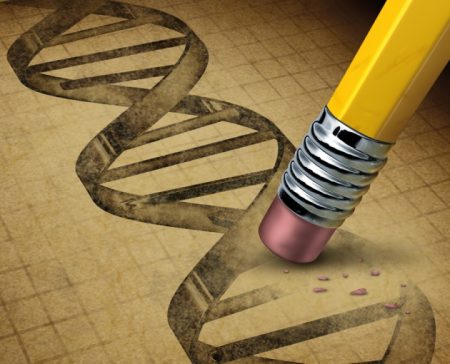May 20, 2017 – Back in April of 2014 I posted musings about altering humans to make us compatible with the harsh reality of Mars and other places we attempt to colonize beyond Earth. CRISPR-Cas9 has changed our perception about the inviolability of genetic code. Add to that we are moving closer to integrating human and machine, combining our sentience and consciousness with cyborg technology to create a living intelligent machine, not bound by the limits of biology.
And we also are developing the means to integrate ourselves with our creations, combining our sentience and consciousness with technology to create a living intelligent machine, not bound by the limits of biology.
Which of these two or will neither be used to help us colonize Mars and other off worlds?
When confronting the risks associated with sending human crews to Mars, let alone establishing ourselves on that very inhospitable world, it appears foolhardy at best to make the attempt. On the International Space Station, in a relatively benign area of space partially shielded by Earth’s magnetic field, we humans over time experience some significant physiological changes. Low-Earth orbit space weakens our immune systems and circulation, leaches calcium from our bones, thins our muscles, alters our visual acuity, and increases our cancer risk. Traveling into deeper space, to the Moon and beyond, could prove to be a death sentence to those making the daring leap.
Currently, the way we adapt to space is to create a habitable Earth-like environment that serves as a fish bowl bubble surrounding us. That means we carry a lot of baggage along with us when we go into space. And it also means so many things can go wrong. Apollo 13 showed us just how limited our survival options were based on the technology of the late 20th century.
Are we better prepared now? We haven’t returned to the Moon since the Apollo Project. And we have yet to test a space habitat in Deep Space that could sustain us for months or years. It won’t be until the early 2020s when NASA’s STS and Orion system launch a crewed mission to near-lunar space to test the durability of long-duration human flight. And that test will fall well short of the timelines needed for a journey to Mars, a stay on the planet, and a return to Earth, easily a multi-year mission.
So it would seem that while we are developing long-duration space flight technology, we might consider alternative approaches to the human challenge of Deep Space and off worlds.
What would it take to harden our species to Deep Space and living on the surface of Mars?
A proposed 500-year plan for the colonization of Mars and space beyond includes genetically altering our species. It includes the genetic engineering of humans to survive in space-based environments and on other planets. Among its recommendations:
- A “do-not-disturb” list of genomic characteristics that remain off limits to any genetic alteration to ensure our human essence remains.
- Improved DNA damage detection and self-repair capability.
- Technology to carry insulated genetic payloads that can then be used upon arrival at an off-world destination to generate supporting life.
- Development of synthetic biology to support off-world and Deep Space human life.
Phase 1 of the plan which involves development of cheap, whole-genome sequencing of human and other mammalian species is to be completed by 2020.
Phase 2 from 2020 to 2040 involves experimentation on integrating new elements into human and mammalian genomes and observing test results.
Phase 3 to 2050 begins the first altered human genome trials.
Phase 4 to 2060 tests altered human genomes in space environments.
Phase 6 (there appears to be no Phase 5) ends at the turn of the 22nd century and involves settlement of altered humans and supporting species on off worlds. Mars isn’t even mentioned.
Phase 7 to 2150 expands our altered genetics to make us tolerant to extreme cold, heat, acid and base environments.
Phase 8 to 2300 sends altered genomes to seed Earth-like exoplanets to make them more compatible for our altered genetics.
Phase 9 to 2400 begins altered human migration to exoplanets.
Phase 10 to 2500 has us engineering a new solar system to become the model for spreading humanity throughout the Milky Way Galaxy and beyond.
And finally, there is a Phase N, a determination on whether we humans should prevent the Universe from self-destruction, reversing expansion while ensuring no implosion, and stopping entropy.
What would it take to integrate us with machines that then colonize space and off worlds?
Today we explore many of the planets, moons, asteroids and other objects within our Solar System using robotic spacecraft, landers, and rovers. Although individually expensive, these one-off machines and missions have produced well beyond our expectations giving us a better understanding of our local space beyond Earth. On Mars, we have discovered an ancient landscape that once supported lakes and streams, and probably exotic life based on trace evidence of organic carbon found in surface rocks. The moons of Jupiter and Saturn reveal frozen ocean worlds and complex geochemistry that could prove to be a place where there is life. Even dwarf-planet Pluto has yielded secrets that indicate a dynamic subterranean world where life may exist.
This machine approach to exploration works really well. The environments in which they operate and explore for multiple Earth years would be hostile to any human making a similar attempt. So why not incorporate the best of both worlds, merging the two to create a spacefaring species, both human and machine? A cyborg.
Cyborg is a term that first appeared in Astronautics magazine back in 1960. Coined by Manfred Clynes and Nathan Kline, it described a human-machine capable of adapting to the extreme environments of space and off worlds. Back in 1960, the two scientists saw in cyborgs, a cybernetic replacement for our fragile biology.
Frederik Pohl, science fiction author, and editor, in two of his novels, Man Plus, published in 1976, and Mars Plus, published in 1994, described a human-machine approach in the colonization of the Red Planet. His cyborgs roamed the surface of Mars with no need for attendant life support. They had all the bells and whistles machine technology could provide.
HUMAI, a California-based organization, is out to realize what Clynes and Kline proposed. The organization describes its mission to transplant a human brain into a bionic body using a brain-computer interface. Each Humai, the name of the bionic being would incorporate artificial intelligence along with its imported biological brain. Synthetic organs would replace human ones. Genetic engineering plus nanotech robots would regenerate and repair the biological brain components preventing aging. Humai will take different shapes and forms to suit the destinations they intend to visit and explore.
Elon Musk recently launched Neuralink, a brain-computer interface initiative. Although not focused on creating cyborgs, the technology could certainly be used for the purpose of freeing humans from being planet-Earth bound.
Clynes and Kline wrote in their 1960 paper:
“If man in space, in addition to flying his vehicle, must continuously be checking on things and making adjustments merely in order to keep himself alive, he becomes a slave to the machine. The purpose of the Cyborg, as well as his own homeostatic systems, is to provide an organizational system in which such robot-like problems are taken care of automatically and unconsciously, leaving man free to explore, to create, to think, and to feel.”
Another alternative
But exploration need not be physical. It can be virtual giving us access to space, planets, moons and other worlds currently far away and environmentally harsh for normal human exploration. We already know how to build spacecraft, landers, and rovers that can act as our eyes and ears through 3D cameras and sensors. So why not use virtual reality to explore the Cosmos allowing us to see, touch and taste exotic environments, all while staying safely back here on Earth. You can get a sense of what this will can be like at “Destination Mars,” NASA’s Kennedy Space Center virtual reality tour in Florida. It uses Microsoft HoloLens headsets and Jet Propulsion Laboratory’s OnSight software plus all the images and data collected from Mars rovers, landers and orbiters to let you walk on the Red Planet.



















[…] The Key to Space Colonization Lies in Altering our DNA or Merging our Sentience with Machine Technol… (21stcentech.com) […]
[…] The Key to Space Colonization Lies in Altering our DNA or Merging our Sentience with Machine Technol… (21stcentech.com) […]